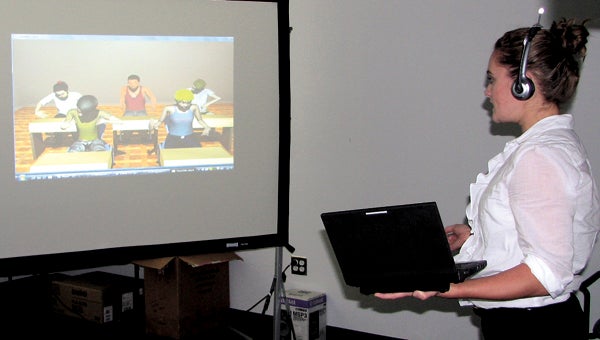Students get virtual dose of classroom
Published 12:49 am Saturday, October 8, 2011

Student-teacher Kate O’Connor practices classroom management in a virtual classroom at Old Dominion University’s Tri-Cities Higher Education Center Friday. Student-teachers try to control the classroom while five student avatars are controlled by a person at the University of Central Florida who can worsen or improve their behaviors.
Dana Olson stood with confidence in front of her classroom and greeted her students before she started her math lesson.
As she went through the intricacies of divisibility, she asked her students for their participation.
“What comes next, Marcus?” she asked.
“This is stupid,” he snapped back. “I don’t see why we are even doing this.”
Olson gently combated his lack of enthusiasm by telling him they were trying to find the pattern. Eventually, the boy gave in and submitted the right answer.
Marcus might have attitude, but he’s supposed to.
As one of five avatars in Olson’s virtual classroom, he’s a test for her to prepare for what she might face after she graduates.
“The first time it was a little strange,” she said. “But it’s kind of cool to talk to them and see their personalities.”
Olson is one of several student-teachers who practice classroom management in a virtual classroom, complete with responsive students, at the Old Dominion University’s Tri-Cities Higher Education Center in North Suffolk.
The Tri-Cities virtual classroom is part of the preparation ODU offers its students enrolled in the Teacher Immersion Residency program, which is designed to help people who want to transition from another career to teaching secondary education.
Before entering the TIR program, Olson was working as a contractor for the Navy and held a degree in applied mathematics, and she decided she wanted to teach.
“While I loved the subject matter (of what I was doing), I realized my passion is teaching,” she said.
As part of the yearlong TIR program, Olson and her classmates will practice in the virtual classroom every Friday until they graduate next spring.
Sharon Judge, the associate dean for the Darden College of Education at ODU, said the classroom simulation is offered as a partnership between ODU and the University of Central Florida, the college that developed the simulation used.
For the lesson, the student-teacher stands in front of a projection screen on which the image of five avatar students in a classroom is projected.
“As a person, they are actually teaching these five students, but it’s a live event,” Judge said. “They can teach, but if they mess up, it doesn’t hurt anything.”
The student-teacher has about 10 minutes with the class, but just like in the real world, they aren’t controlling their own students.
Instead, another person, who is usually an actor or performance artist, from UCF has control over all of the avatars and how they react.
The person at UCF can see and hear everything from the student-teacher and might have the students interrupt the lesson, refuse to participate or give attitude.
Judge said the children represent extreme personality types, and the person controlling them can worsen or improve their behaviors based on how the teacher is handling the classroom.
“As they get comfortable, we can elevate it to make it more difficult,” said Petros Katsioloudis, the assistant professor who hosts the program for the student-teachers.
The teachers have to deal with something as small as one of the students tapping his pen to something more serious, like a student cursing at them.
Also, their lesson is videotaped, so their mentor teachers can watch it with them later and talk about what they did well and what needs improvement.
Olson said while the avatars are extreme stereotypes of children, she thinks the virtual classroom is a good way to learn the things that can happen in the classroom.
“I think it’s good for us to practice,” she said. “I think it helps us with discipline.”
Olson added as nice as the technology is, she thinks it’s necessary to have experience in a real classroom.
Katsioloudis said the virtual classroom isn’t supposed to replace real world experience, but it can be a good tool when used alongside it.
“You use this in conjunction with real student-teaching,” he said. “It’s a perfect tool to expose them to classroom management.”
Judge said she thinks it’s a great way to learn classroom management.
“It’s a way for them to practice teaching,” she said. “They can try out different methods, and it really helps with classroom management. I think it’s wonderful.”
For more information on the TIR program, visit www.education.odu.edu/education/tir/.






